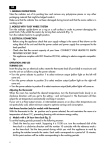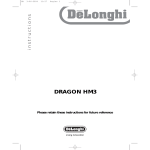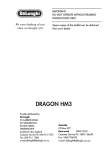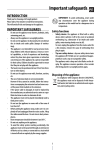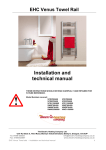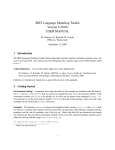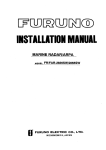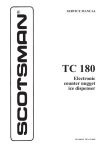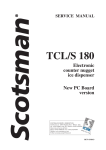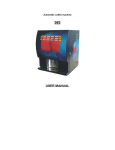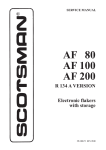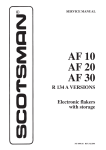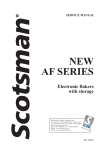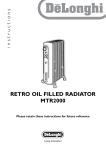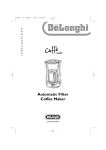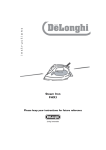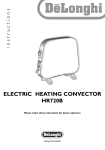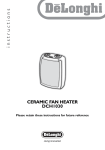Download De'Longhi TRF1 15 User's Manual
Transcript
instructions Oil Filled Radiators TRF1 15 Please retain these instructions for future reference Wheel Foot Wheel Foot Wheel 1 Thermostat Indicator lights display Foot switch 2 3 2 TRF1 15 2 Thank you for choosing this De’Longhi radiator. To get the very best out of your new radiator it is advisable to read these instructions before using it.This will ensure that you gain optimum results and use the appliance safely. General instructions Take the radiator out of its packing box and remove any polystyrene pieces or any other packaging material that might be lodged inside it. Make sure that the radiator has not been damaged during transit and that the mains cable is in working order. Do not operate the radiator if damaged. Fitting the feet Remove the feet and the wheels from the polystyrene packing. Turn the radiator upside-down on a rug or a soft surface in order to prevent damaging the paint finish. Fit the wheels to the spindles and push firmly until they click into position, then insert the foot in it seat and push it till it hooks into position (see fig.1). Electrical connection - Before plugging the radiator into the mains, check that your supply voltage is the same as that shown on the rating plate of the radiator. - If using more than one appliance at a time, it is important to ensure that the ring main is adequate to cope with the power requirements. - It is important to ensure that the socket is adequately earthed. - This radiator complies with EEC Directive 89/336 relating to electromagnetic compatibility. How to use it Switching on Plug the radiator in; position the thermostat slider to the maximum position (6); turn the appliance on by pushing the foot switch as follows: With appliance off: Press the foot switch once: only radiator on (the left side indicator light will switch on ( ). Press the foot switch twice: only fan heater on (the right side indicator light will switch on ( ). Press the foot switch three times: the combined function radiator + fan heater will be on. Press the foot switch four times: the appliance will switch off. 3 TRF1 15 3 Adjusting the thermostat Leave the thermostat at its highest setting until the room has reached the required temperature.Then slowly turn the thermostat slider back until you hear a click.The temperature selected in this way will then be regulated automatically and kept constant by the thermostat. Frost protection function With the thermostat slider in the position and a power selected, the unit maintains the room at a temperature of about 5˚C, preventing freezing with minimum energy consumption. * Cleaning and maintenance Your oil filled raditor is absolutely free from maintenance, fully reliable and will give many years of trouble free service. Wipe radiator with soft damp cloth; do not use detergents or abrasives. If necessary, use a vacuum cleaner to remove any built-up dirt. Some models comes fitted with on anti-dust filter in the ventilation system. Remove periodically the filter from it seat and clean it (fig.3). Attention: if you do not periodically clean the filter it could happen that the fan stops working. If this occur, proceed as follows: 1. Turn the appliance off. 2. Remove the plug from the mains and let the appliance cool down. 3. Remove the filter and clean it well. 4. Replace the filter. Important notes - Do not use your radiator close to bath, wash-basin, shower and swimming pool. - Do not use your radiator to dry laundry. - Never place the power cable on top of the radiator while it is hot. - Only use the radiator in an upright position. - The heater must be positioned at least 50 cm from furniture or other objects. - If the power cable has been damaged, it must be replaced by the manufacturer or the technical service centre or by a qualified person so as to avoid all risks. - In order to eliminate the radiator’s “new” smell, set it to maximum power for at least 8 hours when used for the first time. During this operation, the room in which the radiator is located must be ventilated. - It is perfectly normal for the radiator to make “creacking” sounds when used for the first time. (or in the case of unfrequent use). - The radiator must not be located immediately below a fixed socket-outlet. - The body of this radiator is filled with a precise quantity of special TRF1 15 4 oil, so that repairs requiring the opening of the oil body must only be made by the service agent. Any oil leakage must be reported to the service agent. - Do not use this appliance in rooms having a floor area of less than 4m2 as this can lead to overheating. - If the appliance is scrapped, provisions on the disposal of oil must be respected. - The use of an extension lead is not recommended, as overheating of the extension lead may occur during the operation of the radiator. - As with any electrical appliance, whilst the instructions aim to cover as many eventualities as possible, caution and common sense should be applied when operating your appliance, particularly in the vicinity of young children. The appliance is fitted with a safety device which will switch off it in case of accidental overheating.To reset, contact an authorised service centre. ATTENTION: in order to avoid any danger caused by an accidental resetting of the safety system, this appliance must not be powered through an external timer. IMPORTANT: Never under any circumstances cover the appliance during operation as this would lead to dangerous overheating. IMPORTANT INFORMATION FOR CORRECT DISPOSAL OF THE PRODUCT IN ACCORDANCE WITH EC DIRECTIVE 2002/96/EC. At the end of its working life, the product must not be disposed of as urban waste.It must be taken to a special local authority differentiated waste collection centre or to a dealer providing this service. Disposing of a household appliance separately avoids possible negative consequences for the environment and health deriving from inappropriate disposal and enables the constituent materials to be recovered to obtain significant savings in energy and resources.As a reminder of the need to dispose of household appliances separately, the product is marked with a crossed-out wheeled dustbin. TRF1 15 5 Electrical requirements Before using this appliance ensure that the voltage indicated on the product corresponds with the main voltage in your home, if you are in any doubt about your supply contact your local electricity company. The flexible mains lead is supplied connected to a B.S. 1363 fused plug having a fuse of 13 amp capacity. Should this plug not fit the socket outlets in your home, it should be cut off and replaced with a suitable plug, following the procedure outlined below. Note: Such a plug cannot be used for any other appliance and should therefore be properly disposed of and not left where children might find it and plug it into a supply socket - with the obvious consequent danger. N.B. We recommend the use of good quality plugs and wall sockets that can be switched off when the machine is not in use. important: the wires in the mains lead fitted to this appliance are coloured in accordance with the following code: Warning - this appliance must be earthed Green and Yellow to Earth 13 amp Fuse Brown to Live Blue to Neutral Cord Clamp As the colours of the wires in the mains lead of this appliance may not correspond with the coloured markings identifying the terminals in your plug, proceed as follows: The wire which is coloured green and yellow must be connected to the terminal in the plug which is marked with the letter E or by the earth symbol or coloured green or green and yellow. The wire which is coloured blue must be connected to the terminal which is marked with the letter N or coloured black. The wire which is coloured brown must be connected to the terminal which is marked with the letter L or coloured red. When wiring the plug, ensure that all strands of wire are securely retained in each terminal. Do not forget to tighten the mains lead clamp on the plug. If your electricity supply point has only two pin socket outlets, or if you are in doubt, consult a qualified electrician. Should the mains lead ever require replacement, it is essential that this operation be carried out by a qualified electrician and should only be replaced with a flexible cord of the same size. After replacement of a fuse in the plug, the fuse cover must be refitted. If the fuse cover is lost, the plug must not be used until a replacement cover is obtained. The colour of the correct replacement fuse cover is that of the coloured insert in the base of the fuse recess or elsewhere on the plug. Always state this colour when ordering a replacement fuse cover. Only 13amp replacement fuses which are asta approved to B.S. 1362 should be fitted. This appliance conforms to the Norms EN 55014 regarding the suppression of radio interference. TRF1 15 6 5729000300/04.06 GREEN ANDYELLOW EARTH BLUE NEUTRAL BROWN LIVE






